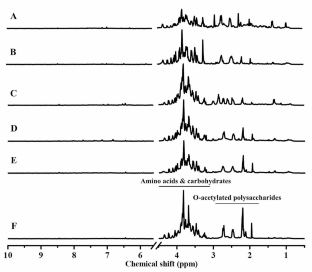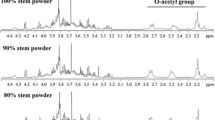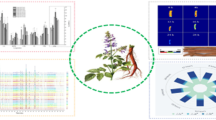Abstract
Dendrobium officinale (D. officinale) as a well-known herbal and functional food material is often adulterated with lower-price Dendrobium species. In this study, we aimed to develop an integrated method of nuclear magnetic resonance spectroscopy and artificial neural network (NMR-ANN) to identify and quantify the adulteration of D. officinale powder with other cheaper species. Microwave-assisted water extraction was selected as a time-saving and green method for sample preparation. The results indicate that the NMR-ANN method effectively quantified the adulteration rate of D. officinale powder with the root mean squared error (RMSE) of 4.92, mean absolute error (MAE) of 3.56 and coefficient of determination (R2) of 0.98 in the model test phase and with the RMSE of 7.65, MAE of 6.30 and R2 of 0.98 in the double-blinded test phase. The whole evaluation process can be done in 6 min and 5 s. Therefore, the NMR-ANN method can be used as a rapid, green and accurate tool for evaluating the quality of D. officinale or even other food materials.





Similar content being viewed by others
Data availability
All data are contained within the article. The data and materials used in this study are available on request from the corresponding author.
References
X.H. Jin, S.C. Singchi, Chen, Y.B. Luo, Taxonomic revision of Dendrobium moniliforme complex (Orchidaceae). Sci. Hort. 120, 143–145 (2009)
W.H. Chen, J.J. Wu, X.F. Li, J.M. Lu, W. Wu, Y.Q. Sun et al., Isolation, structural properties, bioactivities of polysaccharides from Dendrobium Officinale Kimura et. Migo: a review. Int. J. Biol. Macromol. 184, 1000–1013 (2021)
L. Sun, X.M. Chen, C.M. Wu, S.X. Guo, Advances and prospects of pharmacological activities of Dendrobium Officinale Kimura et migo polysaccharides. Acta Pharm. Sinica. 12, 2322–2329 (2020)
Q. Zeng, C.H. Ko, W.S. Siu, L.F. Li, X.Q. Han, L. Yang et al., Polysaccharides of Dendrobium Officinale Kimura & Migo protect gastric mucosal cell against oxidative damage-induced apoptosis in vitro and in vivo. J. Ethnopharmacol. 208, 214–224 (2017)
W. Chen, J. Lu, J. Zhang, J. Wu, L. Yu, L. Qin, B. Zhu, Traditional uses, phytochemistry, pharmacology, and quality control of Dendrobium Officinale Kimura et. Migo Front. Pharmacol. 12, 726528 (2021)
H. Xu, B. Hou, J. Zhang, M. Tian, Y. Yuan, Z. Niu, X. Ding, Detecting adulteration of Dendrobium officinale by real-time PCR coupled with ARMS. Int. J. Food Sci. &Technology. 47(8), 1695–1700 (2012)
K. Zheng, Y. Cai, W. Chen, Y. Gao, J. Jin, H. Wang et al., Development, identification, and application of a germplasm specific SCAR marker for Dendrobium Officinale Kimura et Migo. Front. Plant Sci. 12, 669458 (2021)
H. Dang, X. Zhang, C. Ma, W. Zhao, H. Guo, G. Huang, L. Xie, A transcriptome-based analysis reveals functional differences among Dendrobium Officinale Kimura &Migo species from different growing regions and with different quality levels. Med. Novel Technol. Devices. 16, 100163 (2022)
Y. Wang, Z.T. Zuo, T. Shen, H.Y. Huang, Y.Z. Wang, Authentication of Dendrobium species using near-infrared and ultraviolet–visible spectroscopy with chemometrics and data fusion. Anal. Lett. 51, 2792–2821 (2018)
C. Chu, H. Yin, L. Xia, D. Cheng, J. Yan, L. Zhu, Discrimination of Dendrobium officinale and its common adulterants by combination of normal light and fluorescence microscopy. Molecules. 19, 3718–3730 (2014)
Z. Ye, J.R. Dai, C.G. Zhang, Y. Lu, L.L. Wu, A.G. Gong et al., Chemical differentiation of Dendrobium officinaleand Dendrobium devonianumby using HPLC fingerprints, HPLC-ESI-MS, and HPTLC analyses. Evidence-Based Complement. Altern. Med., 2017, 8647212
Y. Wei, W. Fan, X. Zhao, W. Wu, H. Lu, Rapid authentication of Dendrobium officinaleby near-infrared reflectance spectroscopy and chemometrics. Anal. Lett. 48, 817–829 (2015)
T. Lefebvre, E. Destandau, E. Lesellier, Selective extraction of bioactive compounds from plants using recent extraction techniques: a review. J. Chromatogr. A 1635, 461770 (2021)
A.K. Jha, N. Sit, Extraction of bioactive compounds from plant materials using combination of various novel methods: a review. Trends Food Sci. Technol. 119, 579–591 (2022)
S.B. Bagade, M. Patil, Recent advances in microwave assisted extraction of bioactive compounds from complex herbal samples: a review. Crit. Rev. Anal. Chem. 51, 138–149 (2021)
E.J. Rifna, R. Pandiselvam, A. Kothakota, K.S. Rao, M. Dwivedi, M. Kumar et al., Advanced process analytical tools for identification of adulterants in edible oils–A review. Food Chem. 369, 130898 (2022)
A.P. Sobolev, F. Thomas, J. Donarski, C. Ingallina, S. Circi, F.C. Marincola et al., Use of NMR applications to tackle future food fraud issues. Trends Food Sci. Technol. 91, 347–353 (2019)
L. Jiang, L. Pan, H. Gao, H. Zheng, Rapid identification and quantification of adulteration in Dendrobium officinale using nuclear magnetic resonance spectroscopy combined with least-squares support vector machine. J. Food Meas. Charact. 14, 1427–1432 (2020)
B. Dębska, B. Guzowska-Świder, Application of artificial neural network in food classification. Anal. Chim. Acta. 705, 283–291 (2011)
K. Goyal, P. Kumar, K. Verma, Food adulteration detection using artificial intelligence: a systematic review. Arch. Comput. Methods Eng. 29, 397–426 (2022)
E. Funes, Y. Allouche, G. Beltrán, A. Jiménez, A review: artificial neural networks as tool for control food industry process. J. Sens. Technol. 5, 54322 (2015)
F. Savorani, G. Tomasi, S.B. &Engelsen, .Icoshift: a versatile tool for the rapid alignment of 1D NMR spectra. J. Magn. Reson. 202, 190–202 (2010)
J.L. Aleixandre-Tudó, L. Castelló-Cogollos, J.L. Aleixandre, R. Aleixandre-Benavent, Chemometrics in food science and technology: a bibliometric study. Chemometr. Intell. Lab. Syst. 222, 104514 (2022)
M. Greenacre, P.J. Groenen, T. Hastie, A.I. d’Enza, A. Markos, E. Tuzhilina, Principal component analysis. Nat. Reviews Methods Primers. 2, 100 (2022)
C.L. Lin, C.L. Fan, B.K. Chen, Hybrid analytic hierarchy process–artificial neural network model for predicting the major risks and quality of Taiwanese construction projects. Appl. Sci. 12, 7790 (2022)
M.S. Firouz, M. Omid, M. Babaei, M. &Rashvand, Dielectric spectroscopy coupled with artificial neural network for classification and quantification of sesame oil adulteration. Inform. Process. Agric. 9, 233–242 (2022)
M.T. Hagan, M.B. &Menhaj, Training feedforward networks with the Marquardt algorithm. IEEE Trans. Neural Networks. 5, 989–993 (1994)
K. Hornik, M. Stinchcombe, H. White, Multilayer feedforward networks are universal approximators. Neural Netw. 2, 359–366 (1989)
D.W. Marquardt, An algorithm for least-squares estimation of nonlinear parameters. J. Soc. Ind. Appl. Math. 11, 431–441 (1963)
L.Z. Meng, G.P. Lv, D.J. Hu, K.L. Cheong, J. Xie, J. Zhao, S.P. Li, Effects of polysaccharides from different species of Dendrobium (Shihu) on macrophage function. Molecules. 18, 5779–5791 (2013)
F.G.C. Ekezie, D.W. Sun, J.H. Cheng, Acceleration of microwave-assisted extraction processes of food components by integrating technologies and applying emerging solvents: a review of latest developments. Trends Food Sci. Technol. 67, 160–172 (2017)
A. Krogh, What are artificial neural networks? Nat. Biotechnol. 26, 195–197 (2008)
O.I. Abiodun, A. Jantan, A.E. Omolara, K.V. Dada, N.A. Mohamed, H. Arshad, State-of-the-art in artificial neural network applications: a survey. Heliyon, 2018, 4, e00938
S.H. Ganie, P. Upadhyay, S. Das, M.P. Sharma, Authentication of medicinal plants by DNA markers. Plant. Gene. 4, 83–99 (2015)
G. Ding, X. Li, X. Ding, L. Qian, Genetic diversity across natural populations of Dendrobium officinale, the endangered medicinal herb endemic to China, revealed by ISSR and RAPD markers. Russian J. Genet. 45, 327–334 (2009)
D. Xue, S. Feng, H. Zhao, H. Jiang, B. Shen, N. Shi et al., The linkage maps of Dendrobium species based on RAPD and SRAP markers. J. Genet. Genomics. 37, 197–204 (2010)
X. Ding, L. Xu, Z. Wang, K. Zhou, H. Xu, Y. Wang, Authentication of stems of Dendrobium officinale by rDNA ITS region sequences. Planta Med. 68, 191–192 (2002)
L.E. Wahba, N. Hazlina, A. Fadelah, W. Ratnam, Genetic relatedness among Dendrobium (Orchidaceae) species and hybrids using morphological and AFLP markers. Hortscience. 49, 524–530 (2014)
J.J. Lu, J.Y. Kang, S.G. Feng, H.Y. Zhao, J.J. Liu, H.Z. Wang, Transferability of SSR markers derived from Dendrobium Nobile expressed sequence tags (ESTs) and their utilization in Dendrobium phylogeny analysis. Sci. Hort. 158, 8–15 (2013)
S.C.W. Sze, K.Y.B. Zhang, P.C. Shaw, P.P.H. But, T.B. Ng, Y. Tong, A DNA microarray for differentiation of the Chinese medicinal herb Dendrobium officinale (FengdouShihu) by its 5 S ribosomal DNA intergenic spacer region. Biotechnol. Appl. Chem. 49, 149–154 (2008)
H.Z. Wang, S.G. Feng, J.J. Lu, N.N. Shi, J.J. Liu, Phylogenetic study and molecular identification of 31 Dendrobium species using inter-simple sequence repeat (ISSR) markers. Sci. Hort. 122, 440–447 (2009)
G. Ding, D. Zhang, X. Ding, Q. Zhou, W. Zhang, X. Li, Genetic variation and conservation of the endangered Chinese endemic herb Dendrobium Officinale based on SRAP analysis. Plant Syst. Evol. 276, 149–156 (2008)
Funding
This study was supported by the 2022 Student Partnering with Faculty/Staff Research Program of Wenzhou-Kean University, China (No.: WKUSPS202238).
Author information
Authors and Affiliations
Contributions
Conceptualization: HZ and LLJ; Data curation: HZ; Formal analysis: HZ and KYG; Funding acquisition: LLJ; Investigation: KYG, NY, MJW and YXL; Methodology: KYG, NY, MJW and YXL; Project administration: LLJ; Resources: HZ; Supervision: HZ and LLJ; Visualization: KYG, XLY, HZ and LLJ; Writing - original draft: HZ and LLJ; Writing - review & editing: XLY, KYG, NY, MJW, YXL, HZ and LLJ.
Corresponding authors
Ethics declarations
Ethical approval
Not applicable.
Consent to participate
Not applicable.
Consent for publication
Not applicable.
Conflict of interest
The authors declare that they have no conflict of interest.
Additional information
Publisher’s Note
Springer Nature remains neutral with regard to jurisdictional claims in published maps and institutional affiliations.
Rights and permissions
Springer Nature or its licensor (e.g. a society or other partner) holds exclusive rights to this article under a publishing agreement with the author(s) or other rightsholder(s); author self-archiving of the accepted manuscript version of this article is solely governed by the terms of such publishing agreement and applicable law.
About this article
Cite this article
Gong, K., Yin, X., Ying, N. et al. Rapid and accurate detection of Dendrobium officinale adulterated with lower-price species using NMR characteristic markers integrated with artificial neural network. Food Measure (2024). https://doi.org/10.1007/s11694-024-02538-2
Received:
Accepted:
Published:
DOI: https://doi.org/10.1007/s11694-024-02538-2




